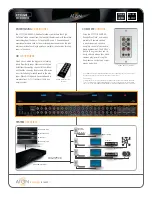
Page 20
TSS MINI Operations Manual
This improved design, sometimes called ‘double conversion’ continuously converts utility
power to DC, stores it in a battery, then produces isolated AC power from an inverter. It
never switches back and forth to utility power, and has better immunity to input
transients, brownouts, and blackouts. Models are available with batteries of almost any
size, making the continuous-conversion UPS suitable for transient suppression or long-
term operating power in the absence of utility power.
Server Operating Environment
A video server is one of the most critical elements in a broadcast operation. Its installation
should safeguard it from every external event that can interfere with it doing the task
expected of it. 360 Systems’ engineers have experience with thousands of installations, and
have become aware of a number of environmental factors that can adversely affect
performance. Two of these have already been discussed: power conditioning and inadequate
cooling. Two others, less obvious, should also be considered:
RF Interference by Cell Phones
Many people are not aware that cell phones produce a very high instantaneous power
output, even when no conversation is taking place. You may have experienced the effect of a
cell phone interfering with a common desk phone placed nearby. Carrying a cell phone into
a machine room where it is in close proximity to broadcast equipment and its associated
wiring is unwise. Cell phones can interfere with serial control commands, video
synchronization, and in some cases can crash the CPU in equipment.
Some major broadcasters prohibit the presence of cell phones in certain equipment areas.
360 Systems believes that the risk of undesired equipment behavior from their RF fields is
very real.
Static Discharge
Static electricity discharge is accepted by most people as an inevitable consequence of living
in a dry area. It is also a result of floor coverings that may enhance appearances, but are
inappropriate for use around critical broadcast equipment. Static discharge can do two
adverse things:
Discharge into a connector can—and will—destroy internal circuitry of equipment. The
result will usually be difficult to diagnose.
Discharge to equipment frames or wiring can crash a CPU and take the station off the air.
The event may seem random or unrelated to static, but it is clearly a catastrophic event—
and one that can repeat indefinitely.
Several steps can be taken to protect equipment from static discharge:
Do not install critical broadcast equipment (video servers) in a room with carpeting.
















































